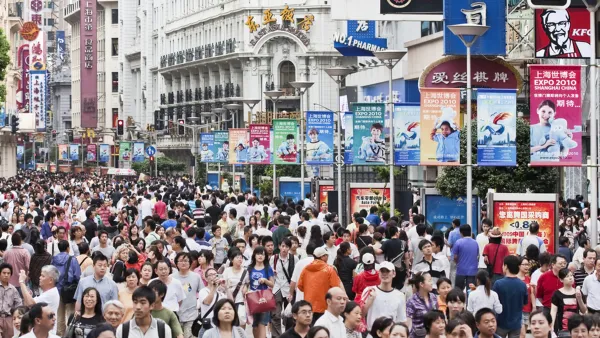China's slowing economy has prompted calls from economists to reconsider the "one-child" policy that has contributed to a shrinking labor pool. It's annual population growth rate was .57% for 2000-2010. By comparison, the U.S. rate was .97%
When China's top national statistician speaks, people listen. Laurie Burkitt writes that Ma Jiantang, the head of the National Statistics Bureau, has pointed to the nation's "shrinking pool of workers" as one cause of the economic growth slowdown. Another cause is "the wide gap between China's haves and have-nots" described in a companion piece by Tom Orlik and Bob Davis.
"You ask if I am concerned about labor-force decline? Yes, I don't want to deny it," Mr. Ma said, adding that leaders should come up with "a more proper, scientific policy."
Mr. Ma's comments come as many Chinese demographers call for an end to the family-planning policy, which was implemented in 1980 to manage a population explosion encouraged by Chairman Mao Zedong. They argue that propping up birth restrictions threatens the country's labor force, which has been the backbone of its economic growth in recent decades.
Wang Feng, a population expert and director of the Brookings-Tsinghua Center for Public Policy in Beijing and a member of a group of demographers, academics and former officials who have been calling for the one-child policy to be replaced with a two-child limit, said a smaller labor force puts upward pressure on wages and will likely result in higher rates of inflation.
There have been prior calls for the nation to reexamine it's strict population control policy that includes "faced abortions and sterilizations", writes Burkitt. Will a top economist's call fare any better? Not according to the head of China's National Population and Family Planning Commission who "dismissed speculation the policy would be scrapped in the near future".
Ironically, one obstacle cited is finding employment for the "hundred of thousand of workers in the family-planning commission".
Labor pool size is closely linked to economic growth. Brad Plumer of The Washington Post Wonkblog describes the relationship as it applies to the U.S. in his May 4, 2012 piece, "The incredible shrinking labor force".
The other concern of Ma Jiantang, income disparity as measured by the Gini coefficient, show's that China division of income is as unequal as the U.S., according to Orlik and Davis. Both issues are further discussed in The Wall Street Journal's ChinaRealTimeReport blog, "A Raft of Surprises From China Stats Chief".
FULL STORY: Pressure Rises on China to Scrap One-Child Policy

Analysis: Cybertruck Fatality Rate Far Exceeds That of Ford Pinto
The Tesla Cybertruck was recalled seven times last year.

National Parks Layoffs Will Cause Communities to Lose Billions
Thousands of essential park workers were laid off this week, just before the busy spring break season.

Retro-silient?: America’s First “Eco-burb,” The Woodlands Turns 50
A master-planned community north of Houston offers lessons on green infrastructure and resilient design, but falls short of its founder’s lofty affordability and walkability goals.

Test News Post 1
This is a summary

Analysis: Cybertruck Fatality Rate Far Exceeds That of Ford Pinto
The Tesla Cybertruck was recalled seven times last year.

Test News Headline 46
Test for the image on the front page.
Urban Design for Planners 1: Software Tools
This six-course series explores essential urban design concepts using open source software and equips planners with the tools they need to participate fully in the urban design process.
Planning for Universal Design
Learn the tools for implementing Universal Design in planning regulations.
EMC Planning Group, Inc.
Planetizen
Planetizen
Mpact (formerly Rail~Volution)
Great Falls Development Authority, Inc.
HUDs Office of Policy Development and Research
NYU Wagner Graduate School of Public Service


























